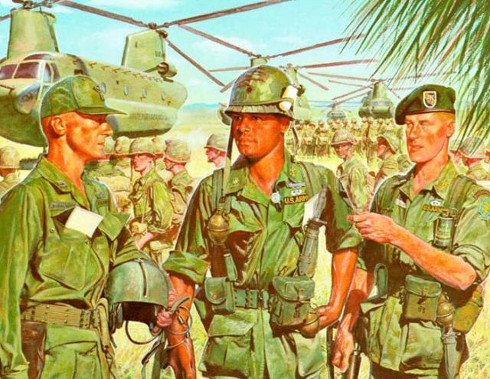- Get link
- Other Apps
In the beginning, the United States had a difficult time completing and maintaining Tropical Uniforms. It was not until 1967 that Tropical Uniforms were authorized for all personnel in the Vietnam war. The supply stocks were stretched and soldiers wore out the lightweight uniforms extremely quickly due to the harsh conditions of the jungle.
Jungle fatigues, as they became known, had similar design characteristics. The coat consisted of two slant pockets on the chest and two lower bellows pockets. Each of these pockets closed with two buttons and a button front closure. The pants consisted of two hip pockets with single-button closure, two slash pockets at the hips and two bellows pockets on the thigh with dual button closure. The left thigh bellows pocket also had a "hidden" survival pocket located inside. The pants could be either button fly or zip.
*An important flaw in the design; there was no re-enforcement in the seat or knees*
"TYPE I"
The first pattern (type 1) jungle fatigues were made for the US in 1963. The uniform was made of 5.5-ounce cotton poplin dyed Army Shade Olive Green 107 or "OG-107". The first pattern coat and the pants had "exposed" buttons. The jungle fatigue coat also had shoulder epaulettes, side take up tabs, and an integrated gas flap that could be buttoned internally to better cover the neck and prevent chemical/gas agents from entering through the front button closure. The pants also had the exposed buttons on the pockets, button side take up tabs and an integrated gas flap. Leg ties were attached in the bellows pockets and could be retracted back into the pocket.
"TYPE II"
In August 1964, the Army Material Command ordered a revision to the jungle fatigue design. They found that the exposed buttons had a tendency to get snagged. The buttons on the coat and pants were covered, but the epaulettes, side take up tabs, and the gas flap was retained. The fabric was changed to 6-ounce cotton poplin to help them wear better.
"TYPE III"
The third pattern fatigues were introduced in late 1966 / early 1967. The coat lost its side take up tabs, gas flap, and shoulder epaulettes. The pants shifted to a slide-tab on the waist and lost the gas flap and leg ties. This pattern is slightly more complicated as it was issued in two classes. Class I was OG-107 (olive green) and Class II was ERDL Camouflage.
Fabric Change
The third pattern jungle fatigues were first produced in poplin cotton with very limited ripstop production occurring in late 1967. In mid/late 1968, the more durable ripstop had taken over the majority of production and 1969 saw the end of poplin production. Despite the manufacturing shift to ripstop, poplin remained the most commonly encountered OD jungle fatigues through 1968 simply due to the volume that had been produced. By 1969, ripstop was seen in large numbers though poplin can be found in use throughout the end of the war.
- Get link
- Other Apps









